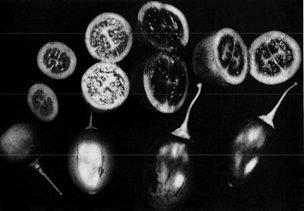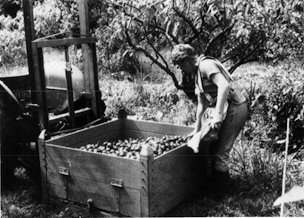Bay of
Plenty, New Zealand. Tamarillo harvest.
HARVESTING AND HANDLING
Fruits
occur in clusters. They can be formed year-round, but in seasonal
countries (such as New Zealand) there is a distinct harvesting season.
Because the fruits do not mature simultaneously (unless the tree has
been pruned), several pickings are usually necessary. The fruits pull
off readily, carrying a short stem still attached.
The trees bear
prolifically and yield generous harvests. A single tree may produce 20
kg of fruit or more each year; commercial yields from mature orchards
in New Zealand can reach 15–17 tons per hectare.
In handling
tamarillos, the most serious problem is fungal rot (glomorella) on the
stem, which can quickly extend into the fruit. Copper sulfate (bordeaux
mixture) controls this adequately. The New Zealand Department of
Scientific and Industrial Research has developed a cold-water dipping
process that is also effective. Storage of 6–10 weeks is then possible.
LIMITATIONS
To
develop tamarillo into a practical, widespread crop will not be quick
or easy. Even selected New Zealand cultivars usually produce a variable
product, insufficiently reliable to assure importers that shape, color,
or sugar:acid ratio will remain consistent lot by lot and year by year.
Nor are future yield levels predictable.
Large leaves and brittle
wood make the trees prone to wind damage. Even light winds easily break
off fruit-laden branches. In most locations, permanent windbreaks
should be established at least two years before the plants are set out.
Even then, staking may be needed to keep branches from breaking under
the weight of fruit.
Small,
hard, irregular, “stones,” containing large amounts of sodium and
calcium, occasionally appear in the fruits. They usually occur in the
outmost layers of the fruit and do not present much of a problem in
fresh fruits because those layers are not eaten. In canning, however,
they are a concern because the whole fruit is used. Probably the best
solution is a breeding program to select for types without these
concretions.
The tree is generally regarded as fairly pest resistant. However, some
pests of concern are given below.
Viruses
In most places, viruses are the most significant diseases. They reduce
the plant's vigor and can leave unattractive splotches on the fruit.
Newly emerged seedlings are, as a rule, virus free, but unless
precautions are taken they soon become infected. (The vectors are
mainly aphids.)
4
Nematodes
Root-knot nematodes damage plants, particularly in sandy soils. Insects
The trees are attacked by aphids and fruit flies, and whitefly is
sometimes a serious pest.
5 In the Andes, the
tree-tomato
worm (which also infests the tomato and the eggplant) feeds on the
fruits, sometimes causing heavy losses.
Fungi
The principal fungal disease is powdery mildew, which can cause serious
defoliation.
Dieback
A dieback of unknown origin is at times lethal to the flowers, fruits,
twigs, and new shoots.
RESEARCH NEEDS
Germplasm
Collection
More types need to be collected and information on their economic
traits developed. Identifying and selecting superior
germplasm—especially that found in the Andes—could assist breeding
programs and speed the tamarillo industry toward success.
Breeding
To support the orderly genetic development of this crop, more
information is needed on the plant's reproduction habits and genetics.
Long-term breeding aims should include virus-resistant trees,
low-growing trees, and deeper-rooted trees. To increase yields,
improved fruit set is needed. This is probably not genetic, but the
reason for flower and fruit abortion is not established.
Other breeding goals should be:
• The development of pure seed lines to enable the growing of desirable
ypes from seed;
• Raising sugar:acid ratios;
• Developing fast-maturing and cold-hardy types to increase the area of
potential use in temperate climates; and
• Creating dwarf cultivars.
Plantation
Management Improvements are needed in orchard practice and
management. Among specific research needs are the following:
• Controlling viruses;
• Increasing fruit set;
• Developing fertilizer requirements;
• Learning the ideal pH level;
• Applying trickle and overhead irrigation;
• Developing growing systems;
• Understanding the plant's nutrition; and
• Breaking seed dormancy.
6
Biological control of the tree-tomato worm should be sought for use in
the Andes. (Perhaps
Bacillus
thuringensis would be useful.)
Sweetness
There seems to be a good possibility that the sweetness of the deep-red
fruits can be raised. Already, sweet types are known; however, these
are mostly smaller or less eye-catching. Nevertheless, low-acid red
specimens have been reported.
7 These deserve
greater
attention because the combination of the spectacular red color with a
sweet taste would cause this appealing fruit to take off.
Stones
The cause of the “stones” should be determined, and methods developed
to eliminate or circumvent this nuisance.
Postharvest
Handling
Work should continue on storage and handling to increase shelf life and
to enable tamarillos to be shipped by sea—a development expected to
greatly improve the export situation for most countries. Important
advances have already been made.
Hybrids
Several closely related species (see below) produce good fruit, and
there is the potential of developing hybrid tamarillos, perhaps with
seedless fruits and different flavors. There seem to be substantial
genetic barriers to interspecific hybrids, however.
8
Nonetheless, cell fusion and gene splicing, which seem particularly
easy in Solanaceae, might prove practical.
Tissue Culture
Tissue-culture techniques have been developed for the tamarillo.
Although their main use will be in multiplying improved material for
planting, they are possibly useful in genetic selection and in
propagating of difficult hybrid crosses and haploids. Colchicine
treatment to produce fertile plants from haploids should be attempted.
Work
is currently under way to select a virus-resistant strain with the aid
of tissue culture. In the meantime, however, virus resistance should be
sought in wild species.
SPECIES INFORMATION
Botanical Name
Cyphomandra betacea (Cavanilles) Sendtner
Family
Solanaceae (nightshade family)
Common Names
Spanish:
tomate de árbol, tomate extranjero, lima tomate, tomate de palo, tomate
francés
Portuguese:
tomate de érvore, tomate francês
English:
tree tomato, tamarillo
Dutch:
struiktomaat, térong blanda
German:
Baumtomate
Italian:
pomodoro arboreo
Origin.
The tamarillo is unknown in the wild state, and the area of its origin
is at present unknown. It is perhaps native to southern Bolivia (for
example, the Department of Tarija) and northwestern Argentina (the
provinces of Jujuy and Tucumán).
Description.
The plant is a fast-growing herbaceous shrub that reaches a height of
1–5 m (rarely 7.5 m). It generally forms a single upright trunk with
spreading lateral branches. The leaves are large, shiny, hairy,
prominently veined, and pungent smelling.
Flowers and fruits hang
from the lateral branches. The pinkish flowers are normally
self-pollinating, but can require an insect pollinator; unpollinated
flowers drop prematurely.
The fruits are egg shaped, pointed at both
ends, 4–10 cm long and 3–5 cm wide, smooth, thin-skinned, and
long-stalked. The skin color may be yellow or orange to deep red or
almost purple, sometimes with dark, longitudinal stripes.
The flesh
inside is yellowish, orange, deep red, or purple. It has a firm texture
and numerous flat seeds. The most flavorful and juicy flesh lies toward
the center of the fruit, becoming more bland toward the skin.
Horticultural
Varieties.
Although there is much variety in the fruits and many local preferences
based on color, there are apparently at present few named cultivars.
Growers normally select their own trees for seed selection.
In New
Zealand, where the most extensive selection has taken place, two
strains are cultivated: red and yellow. Oratia Red (or Oratia Round)
was the first recognized cultivar. The red strain has a stronger, more
acid flavor and is more widely grown. Yellow fruits have a milder
flavor and are preferred for canning. A dark-red strain (called
“black”) was selected in New Zealand in about 1920 as a variation from
the yellow and red types. It was propagated and reselected thereafter.
Environmental Requirements
Daylength.
Unknown; probably daylength-insensitive.
Rainfall.
Cannot tolerate prolonged drought, nor waterlogged soils or standing
water.
Altitude. Unrestricted. Grows at 1,100–2,300 m at the equator in the
Andes; near sea level in New Zealand and other countries.
Low
Temperature. This species is injured by frost. Short
periods below `2°C kill all but the largest stems and branches.
High
Temperature.
In tropical lowlands, tamarillos grow poorly and seldom set fruit.
(Fruit set seems to be affected strongly by night temperature.) The
plant seems to do best in climates where daytime temperatures range
between 16 and 22°C during the growing season.
Soil Type.
Fertile, light, well-drained soil seems best.
Related
Species. The genus
Cyphomandra,
native to South and Central America and the West Indies, contains about
40 species. Many that are grown for their fruits remain to be
investigated. Several are said to produce fruits as good as those of
the cultivated tamarillo. These may hold potential as economic crops in
their own right, or as germplasm sources for improving the tamarillo.
Fruit-bearing species deserving special studies include the following:
Cyphomandra
casana (C.
cajanumensis)
Found growing wild on the edge of rain forests in the highlands of
Ecuador, especially in the Loja Province. Like the tamarillo, the
casana grows rapidly to a small tree, 2 m tall. Its large, furry,
deep-green leaves make it an interesting ornamental, but it also
produces heavy crops of mild-flavored fruits in about 18 months. The
fruits are spindle shaped and golden yellow when ripe. They are sweet,
juicy, and said to be rather like a blending of peach and tomato in
flavor.
The casana seems to need cool growing conditions. Unlike the
tamarillo, the casana fruit is a poor shipper. A breeding program for
selection of firmer, larger, and better colored fruit could yield a
fruit of commercial value. It deserves special attention from
horticulturists and scientists as a source of genetic material for such
qualities as nematode resistance, root rot resistance, fragrance,
flavor, color, and yield.
Cyphomandra
fragrans
Compared with the tamarillo, this tree has greater tolerance to powdery
mildew, a smaller and more robust stature, basal fruit abscission (the
fruits break away clean without the stalk as found on tamarillos), and
a greater degree of cold hardiness. Its fruits resemble small
tamarillos, but have a thick and leathery orange skin. Like most
solanaceous fruit, it is somewhat acid.
Cyphomandra
hartwegi This
species has an extensive natural range, but is not yet commercially
cultivated. Apparently, it has not even been tested as a potential
crop. It has a yellow berry about the size of a pigeon's egg.

